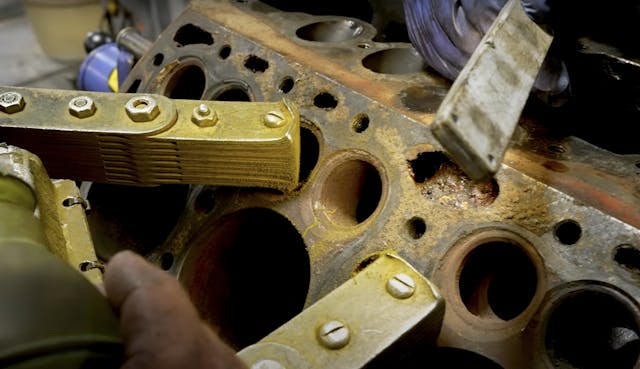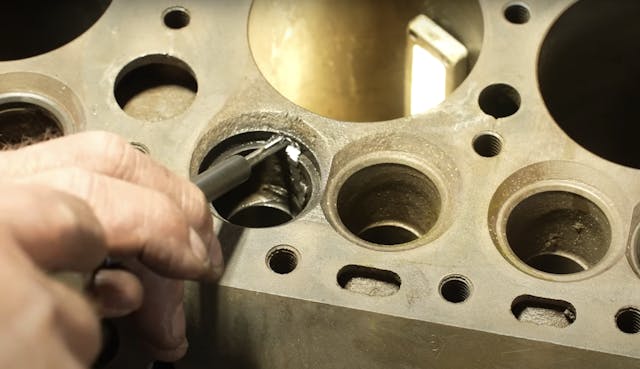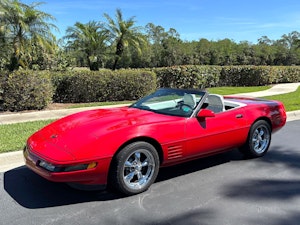Media | Articles
Listen to This Flathead Run Again After 50 Years in Storage
Engines are at once surprisingly delicate and amazingly robust. The explosive forces contained within their combustion chambers are shockingly powerful, and it only takes one small crack to send an otherwise perfect engine block to the scrap bin. Well, not every damaged block gets melted down to become something else. Some people are dedicated to fixing things, and thanks to one shop, there’s one more Flathead Mercury V-8 headed into a car rather than into the bin.
This specific engine comes by way of Jim’s Automotive Machine Shop in Colorado. The engine sat for decades before crossing the threshold of Jim’s shop door nearly eight months ago. Once there, the news was about what could be expected for a seized engine that had been stored for 50 years: A crack had formed across the one of the valve seats, which was quite an involved repair. Since the valve seats on a flathead are part of the engine block and not the cylinder head, the repair is trickier, and the consequences are much higher. Luckily, an experienced machine shop has solutions for a lot of things that we at-home DIY folks might not be familiar with.
The crack was a problem that needed to be dealt with before anything else could be done on the engine: There was no sense in taking the time to set up and bore all the cylinders just to find the crack was a fatal flaw after all. The repair started with cleaning to more clearly see what lay before them. It progressed to drilling the crack and installing threaded overlapping pins that effectively tied the block back together and allowed a new valve seat to be pressed in along with a sleeve for the bore of that cylinder. A pressure test—since the crack is on the exhaust side and will see pressure, unlike an intake seat, which would see vacuum—showed promise, so the rest of the work was done. The engine got fully restored and headed over to the shop dynamometer.


On the stand, the team primed the oil system and then fired it up. After getting it running and confirming the timing, it was time for a good long run-in and retorquing the cylinder heads. Then the father-son team agree to make power pulls from 1200rpm to 3000rpm—a short pull compared to modern cars, but the rev ceiling of a flathead is that low thanks to flow characteristics of the engine. There’s plenty of restriction.
Marketplace
Buy and sell classics with confidence


Even with all that restriction and a repair under one of the valve seats, the engine made 75-80 horsepower on the older dyno. That’s right in line with factory ratings for Flathead engines, so we think this one is ready to go back in a car and get some miles.
















After watching this and the initial build video, I have to say that you’re in the clear with the crack repair. If it had failed, you would see evidence in three places. The exhaust would have steam being expelled, the road draft tube would be huffing out steam, and your oil would be showing the water intrusion by turning chocolate milk like. The water in the exhaust is most likely simply condensate from the cast iron cooling down from the previous run. The temperature difference between sides is probably indirectly linked to either the copper shim gasket holes being smaller iirc, or perhaps the speed difference in the driven speed of the pumps. The combined flow of the t fittings should not have much effect on coolant temperatures. The radiator in a car is connected with each side with the upper and lower tanks anyway.
Great job on the build, I do enjoy seeing these engines come back to life, I have 3 of the 49-53 engines and an actual 1940 60 hp engine all complete. They are great, durable engines, fun to work on and as reliable as the sunrise.
It was a fun video to watch. That engine idling in the background was kind of nice to listen to also.
I had a 47 Merc block ported, relieved bored, balanced and stroked in a 47 chopped Ford convertable and a Carson top with Frenched every thing that could be
Didn’t have a dyno but it was strong enough to break axles
It’s a “road draft tube” all cars had them prior to 1967-ish.
PVC valves eliminated the need for them.
My 1960 plymouth valiant slant six (170cid, mechanical lifters adjusted every 10K) had a road draft tube. Critical to have the open ellipse of the slant cut tube facing backwards in order to have a small negative pressure evacuate the crankcase fumes.
I havs a 39 Ford Sedan with a 46 Ford full race engine in. It has a 3/4 Iskendarian cam shaved heads dual exhasts and a electric fuel pump. I’m 81years old and have owned the car since I was 16yrs old.
Thanks
BeachBoys had a song about a little deuce coupe with a flathead mill that would 140 in the top end floored. I always found that hard to believe given even a 42 ford 60 flathead….Still, flatheads with Ardun heads if not a twin overhead cam conversion are pretty cool. I googled that some flatheads produce over 700hp (for a short while LOL).
Can put that in my ’49 Ford p/u!
I loved the sound of that engine. Thanks. It brought back plenty of Great memories. I installed a ’48 Merc V-8 in my ’40 Ford coup Deluxe. The engine that I built, had Edelbrock Aluminum heads, A 3 pot manifold, Carter 97 Carbs with progresive linkage. Scheafer dual disk clutch, 39 Ford Pick-up truck transmission, Malory Duel Coil Spark ignition. 800×15 tires on the back, 6″ dropped front axel. It was clean and the engine idled at 800 RPM. Of course, I had to ‘get-on-it’ once and a while. I got really good at dropping the transmission to replace the cluster gear (3 times), the U-joint once (replaced with a truck U-joint.) When I snapped the closed drive-shaft and there was only one in town (San Bernardino) to be found, I drove it gingerly until I sold it. BUT, I loved the sound of the engine and I was a member of the causually organized “Flat-Heads Forever” club. Thanks again for your loving restoration of that engine and my memories.
A gasoline engine generates a little more than one gallon of water in the exhaust for every gallon of gasoline burned. When the exhaust is cool, some of the water can condense.